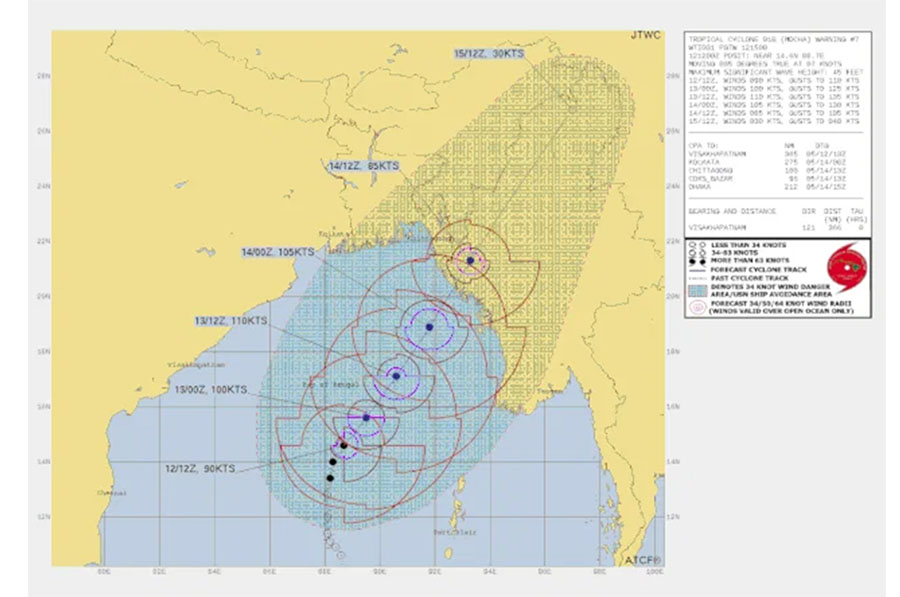
Published :
Updated :

Bangladesh has started preparations to move to safety hundreds of thousands of people from the potential path of Mocha, which has turned into a very severe cyclonic storm, prompting the authorities to raise the warning steeply to a great danger signal.
The districts and seaports of Chattogram and Cox’s Bazar, along with 10 other districts, were under signal No. 8, with No. 10 being the highest alert, on Friday night, as the storm is expected to make landfall near the borders with Myanmar on Sunday. A virtual signal No. 11 means a total communication cut-off.
The Met Office said Chattogram and Cox’s Bazar might face wind-driven storm surge of 8-12 feet above the normal level under the peripheral effect of the storm. The storm surge in the other districts with the great danger signal is likely to be 5-7 feet above the normal level.
The 10 other districts under the great danger signal are Feni, Noakhali, Laxmipur, Chandpur, Barishal, Bhola, Patuakhali, Jhalakathi, Pirojpur and Barguna.
The cyclone was around 800 kilometres from the ports. The maximum sustained wind speed within 74 kilometres of the storm centre is about 150 kilometres per hour, rising to 170 kph, Bangladesh Meteorological Department said in a special bulletin.
Meteorologists have warned of heavy rains during and under the influence of the storm. Azizur Rahman, the director of the Bangladesh Meteorological Department, said the rain trend with wind gusts will increase along the coasts on Saturday evening.
“The storm has drawn all the clouds for a week. They will return to the land with the cyclone.”
Arifuzzaman Bhuiyan, the executive engineer at the Flood Forecasting and Warning Centre, said heavy downpours might cause flash floods in the coastal areas.
Md Mijanur Rahman, director general at the Department of Disaster Management, said they instructed the head of administration in 20 districts and the sub-districts under them in a virtual meeting.
They are prioritising Cox’s Bazar, especially Saint Martin’s Island, in the preparatory efforts. Chattogram is also expected to suffer extensive damage due to the storm.
More than 1,500 storm centres have been prepared, with a target to evacuate 500,000 people in the two districts, said Mijanur. “We’re focussing on the efforts to ensure adequate food, safe shelter and special care for women, children and the elderly.”
Volunteers and government workers were using loud hailers to request the residents of the coastal areas to move to safety before Saturday night.
Many residents, along with all the tourists, have left St Martin’s Island. “The volunteers are helping us there. The storm shelters are also ready. We have stocked food for one week,” Mijanur said.
The disaster management and relief ministry said it allocated Tk 3.4 million cash for Chattogram and Cox’s Bazar districts. It will also distribute 1,200 tonnes of rice, 7 tonnes of biscuits, 6 tonnes of cake and water-purifying tablets.
DISRUPTION
The authorities suspended river transport across Bangladesh from Friday night and flight operations at Shah Amanat International Airport in Chattogram from Saturday morning.
The government postponed the Secondary School Certificate or SSC exams slated for Sunday under Chattogram, Barishal, Cumilla, technical and madrasa boards.
Sunday’s exams under the National University have also been postponed.
The power, energy and mineral resources ministry said it halted supplying LNG from two floating terminals in Cox’s Bazar.
The Chattogram port has been put on the highest alert. The docked ships are being moved to the outer anchorage.
ROHINGYA IN DANGER
International organisations, including the United Nations, have voiced concern over the safety of the nearly 1 million Rohingya refugees who are living mostly in Cox’s Bazar after fleeing violence and persecution in Myanmar.
The world’s largest refugee encampment for the Rohingya in Cox’s Bazar is on the potential path of the storm.
Their shelters made of bamboo, and tin and polythene sheets are feared to take heavy damage.
The World Meteorological Organization warned of violent winds, floods and possible landslides in Bangladesh that could hit the refugee camps.
UN refugee agency spokesperson Olga Sarrado said preparations were underway for a partial evacuation of the camp if needed. The agency was also preparing tens of thousands of hot meals and jerrycans, she said.
The World Health Organization said it was pre-positioning some 33 mobile medical teams, 40 ambulances as well as emergency surgery and cholera kits for the camp.
The International Organization for Migration said it mobilised 1,060 members of Women Participation Project and 800 female members of Disaster Management Unit for participating in cyclone awareness campaigns, including early warning, evacuation procedure and emergency preparedness kits.
Ten mobile medical teams were on standby with 14 ambulances, while 400 health workers were on cautionary response, the IOM said.
At Bhasan Char island, where nearly 30,000 of the Rohingya have been relocated, the authorities have prepared 55 shelters.
“We’ve arranged cooking for 30,000 people. The solar panels have been secured so that they are not blown away. The livestock and shepherd will be brought in,” said Humayun Kabir, chief of Bhasan Char Police Station.
Shihab Uddin Shahin, a Red Crescent Society official, said they were ready to shelter 20,000 Rohingya in tents with food and medical treatment facilities.
Although he is hopeful about keeping casualties at zero with “little chances of storm surge and hills slowing the wind”, Refugee, Relief and Repatriation Commissioner Mohammad Mizanur Rahman is not ruling out flash floods or landslides in the camps.
“In that case, we’ve planned to relocate the refugees from places vulnerable to landslides.”
As many as 3,300 volunteers in the 33 refugee camps, including 26 in Ukhiya and seven in Teknaf, are ready to work in coordination with government and non-government organisations, according to him.


 For all latest news, follow The Financial Express Google News channel.
For all latest news, follow The Financial Express Google News channel.